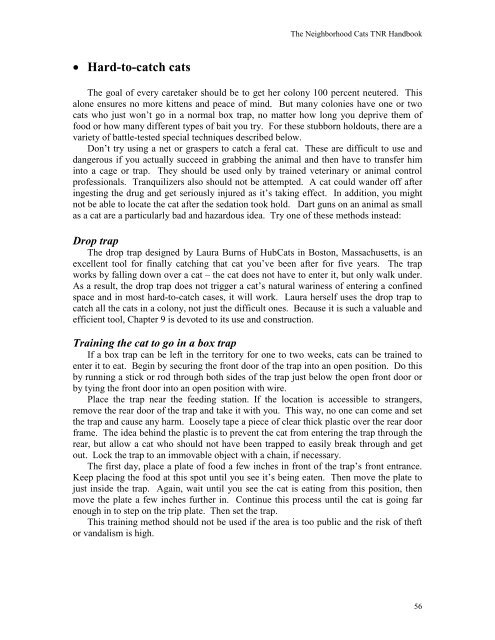You also want an ePaper? Increase the reach of your titles
YUMPU automatically turns print PDFs into web optimized ePapers that Google loves.
• Hard-to-catch cats<br />
The <strong>Neighborhood</strong> <strong>Cats</strong> <strong>TNR</strong> <strong>Handbook</strong><br />
The goal of every caretaker should be to get her colony 100 percent neutered. This<br />
alone ensures no more kittens and peace of mind. But many colonies have one or two<br />
cats who just won’t go in a normal box trap, no matter how long you deprive them of<br />
food or how many different types of bait you try. For these stubborn holdouts, there are a<br />
variety of battle-tested special techniques described below.<br />
Don’t try using a net or graspers to catch a feral cat. These are difficult to use and<br />
dangerous if you actually succeed in grabbing the animal and then have to transfer him<br />
into a cage or trap. They should be used only by trained veterinary or animal control<br />
professionals. Tranquilizers also should not be attempted. A cat could wander off after<br />
ingesting the drug and get seriously injured as it’s taking effect. In addition, you might<br />
not be able to locate the cat after the sedation took hold. Dart guns on an animal as small<br />
as a cat are a particularly bad and hazardous idea. Try one of these methods instead:<br />
Drop trap<br />
The drop trap designed by Laura Burns of Hub<strong>Cats</strong> in Boston, Massachusetts, is an<br />
excellent tool for finally catching that cat you’ve been after for five years. The trap<br />
works by falling down over a cat – the cat does not have to enter it, but only walk under.<br />
As a result, the drop trap does not trigger a cat’s natural wariness of entering a confined<br />
space and in most hard-to-catch cases, it will work. Laura herself uses the drop trap to<br />
catch all the cats in a colony, not just the difficult ones. Because it is such a valuable and<br />
efficient tool, Chapter 9 is devoted to its use and construction.<br />
Training the cat to go in a box trap<br />
If a box trap can be left in the territory for one to two weeks, cats can be trained to<br />
enter it to eat. Begin by securing the front door of the trap into an open position. Do this<br />
by running a stick or rod through both sides of the trap just below the open front door or<br />
by tying the front door into an open position with wire.<br />
Place the trap near the feeding station. If the location is accessible to strangers,<br />
remove the rear door of the trap and take it with you. This way, no one can come and set<br />
the trap and cause any harm. Loosely tape a piece of clear thick plastic over the rear door<br />
frame. The idea behind the plastic is to prevent the cat from entering the trap through the<br />
rear, but allow a cat who should not have been trapped to easily break through and get<br />
out. Lock the trap to an immovable object with a chain, if necessary.<br />
The first day, place a plate of food a few inches in front of the trap’s front entrance.<br />
Keep placing the food at this spot until you see it’s being eaten. Then move the plate to<br />
just inside the trap. Again, wait until you see the cat is eating from this position, then<br />
move the plate a few inches further in. Continue this process until the cat is going far<br />
enough in to step on the trip plate. Then set the trap.<br />
This training method should not be used if the area is too public and the risk of theft<br />
or vandalism is high.<br />
56


